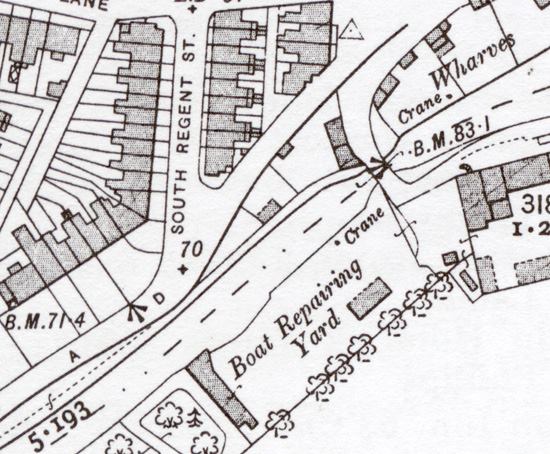Triangle History: The Site
Introduction
The Triangle was formed in the 1790s by the construction of the Lancaster Canal, which turned a piece of land lying adjacent to Aldcliffe Road (then Aldcliffe Lane) into a wedge-shaped plot, having as its shorter third side the then newly built Basin Bridge.
Designed by John Rennie of Lune Aqueduct fame, Bridge 98 is one of Lancaster’s two ‘roving’ or ‘turnover’ bridges, built to allow the towpath to cross from the west side of the canal to the east, avoiding the coal wharves next to the canal basins. Horses were backed over the bridge still hitched to their towing barges, their tow-ropes gliding smoothly over the metal staples which connect the coping stones on the parapet.
Timeline
1831
An early mention of Basin Bridge occurs in the Lancaster Gazette of 2 July 1831, referring to the “stopping up of an unnecessary footway” leading from Samuel Gregson’s land on Ashton Road via Springfield Hall, to the canal towpath, “near one of the Bridges over the Lancaster Canal Navigation, called Basin Bridge”.

1845
In this map there are as yet no buildings on the Triangle, but a sandpit is shown adjacent to Aldcliffe Road.

1877
No buildings shown.

1887
Report of Council Meeting
OCCUPANCY OF LAND. At a meeting of the Streets Committee on the 18th inst., an offer by the Canal Company to let a portion of land adjoining the Urban Authority’s yard abutting on the canal, at £1 per year was accepted.
Lancaster Gazette, 30 July 1887
Could this refer to the Triangle?
At the same meeting, Joe Johnson, a pavior from Salford who was later to become a tenant of the Triangle tendered for “various back streets” – £220 19s 3d.
1890
3/4 buildings on Triangle (plot divided in half): one straddling land near pointed end, one (or two) built onto bridge and one adjacent to Aldcliffe Road.
1892
Two adjoining OS maps. Notice the gaps in the perimeter wall allowing for access to the Triangle.

1893
Report of Council Meeting
PRIVATE IMPPROVEMENT WORKS: Tenders were submitted for the private improvement works… in Carr House Lane. Resolved that the following tender of Mr Joe Johnson be accepted: £119. 11s. 8d.
1899
A local resident has mentioned that he remembered a builder called Joe Johnson using the site. This is corroborated by the trade directory of 1899 which shows the businesses along Aldcliffe Road: 5 coal merchants, then “Johnson Joe, pavior, contractor, asphalter, dealer in setts, cobbles, gravel, sanitary ware, etc.” (house Brook Street) and corresponds with the 1890 and 1892 OS maps showing the series of five coal wharves and then the Triangle.

1901
1901 Lancaster Morecambe and District Directory (Lancaster Library): Johnson, Joe, pavior, asphalter and contractor, Aldcliffe Road; house 36 Cromwell Road.

1910
The 1910 map shows the plot divided into three, with a building adjacent to the towpath wall.

1929
An entry in a 1929 Trades Directory at Lancaster Library reads, “Joe Johnson, Pavior, Aldcliffe Road”.
1934
In the Lancaster & Morecambe Directory for 1934 held at the Lancashire Record Office an advert reads: “Joe Johnson, John W. Illingworth, Pavior and General Contractor, Office Aldcliffe Road, estimates given for road making of all descriptions, hard tennis courts, bowling greens, paving, flagging, tar-macadam, excavating, concreting, drainage work, sewering, etc.” No Johnsons appear in the Streets Directory for 1934 at 36 Cromwell Road.
1946
It appears that Johnson’s firm has now moved out of the Triangle. “Joe Johnson (Contractors) Ltd. Ajax Works, Ridge Lane, Lancaster; Registered No. 00413688, incorporated 26.6.1946”
source:uk data.com
1956-57
“Thomas Johnson (builders) Ltd. Aldcliffe Road (No. 5) and Johnson, Joe (Contractors) Ltd. 21 Meeting House Lane”
Lancaster and District Directory
1958-59
The following listed at 5 Aldcliffe Road: “Bateson, T.J. joiner; Bateson, B. Signwriter; Airey, John, painter; Denny, F., boot (boat?) repairer; National Coal Board; Fox, George & Co. Coachbuilders & painters;Hodgson, C., builder; Johnson, Thomas (Builders) Ltd.” A box advert for Thomas Johnson describes his firm as “Contractors to Lancaster Corporation… Public Mortar Mills and Yard, Aldcliffe Road. For Sale of Concrete Heads, Steps etc.”
Lancaster and District Directory
1960s
Then and now…
Here is the canal and Triangle towpath wall giving some idea of the openings that were there at the time. The boat-house opposite is derelict and has no roof. We are grateful to Graham Hibbert for allowing reproduction of photos from his Flickr photostream. There are more of his photos on the David Vause page.


1970
T. Johnson (Builders) Ltd., Aldcliffe Road
Lancaster Directory
1980 to 1996
In the 1980s and 1990s the Triangle was used by local boatbuilder David Vause to construct and repair punts that were hired out for pleasure use from the Navigation pub on the far side of Penny Street Bridge, as permission to launch them from the towpath by Basin Bridge had been refused. The building on the Triangle adjacent to Aldcliffe Road was used as a workshop and the lean-to was a storage area for the finished punts. David named the yard “Paradise Garden” after Frederick Delius’s intermezzo from his opera ‘A Village Romeo and Juliet.’

1996 to 2012
After David Vause’s death in 1996, his Paradise Garden fell into disrepair.

